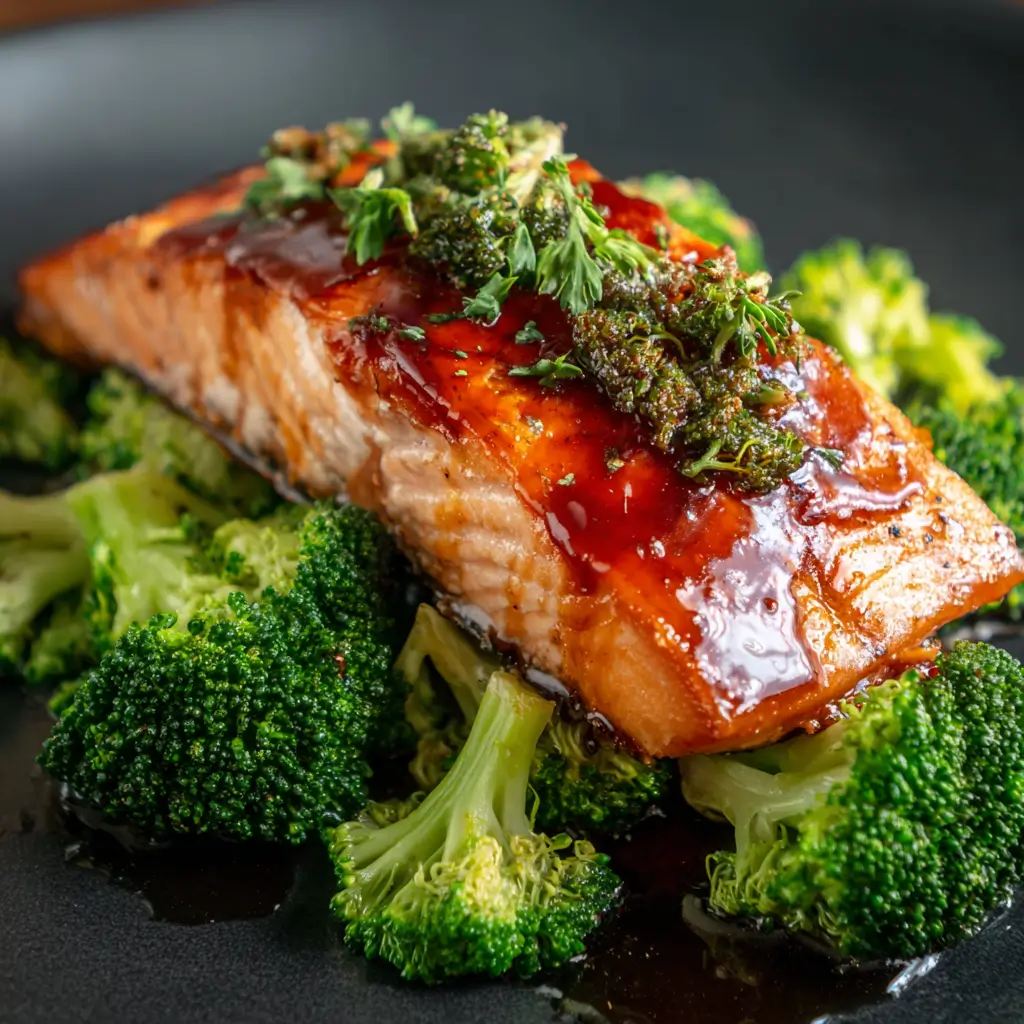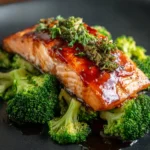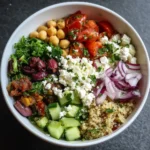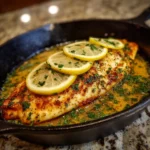Teriyaki Glazed Salmon with Broccoli: A Flavorful, Healthy One-Pan Meal
There’s something undeniably satisfying about a meal that combines rich umami flavors, vibrant colors, and nutritious ingredients—all on a single pan. Teriyaki Glazed Salmon with Broccoli is exactly that kind of dish: elegant enough for a dinner party yet simple enough for a weeknight family meal. This Japanese-inspired recipe brings together tender, flaky salmon fillets bathed in a glossy homemade teriyaki sauce, paired perfectly with crisp-tender broccoli florets roasted to perfection. Not only does it deliver bold flavor and visual appeal, but it also packs a punch when it comes to health benefits, making it a favorite among home cooks who value both taste and wellness.
The History of Teriyaki and Its Culinary Journey
The word teriyaki originates from Japan, where “teri” refers to the lustrous sheen imparted by the sauce, and “yaki” means grilled or broiled. Originally developed in the 17th century, teriyaki was a method used to preserve and enhance the flavor of fish and meat by grilling them with a glaze made from soy sauce, mirin (sweet rice wine), and sugar. Over time, this cooking technique evolved and spread beyond Japan’s shores, particularly gaining popularity in Hawaii and North America during the 20th century.
Japanese immigrants brought their culinary traditions with them to Hawaii, where local ingredients like pineapple juice and ginger were incorporated into traditional recipes, giving birth to a sweeter, more accessible version of teriyaki. Today’s Americanized teriyaki often features a thicker, syrupier sauce compared to its Japanese counterpart, which tends to be lighter and less sweet. The global love for teriyaki has led to countless adaptations—from chicken and beef to tofu and now salmon—each bringing its own twist while honoring the essence of shine, sweetness, and savory depth.
Ingredients Breakdown: What Makes This Dish Shine?
The magic of Teriyaki Glazed Salmon with Broccoli lies not just in how it’s prepared, but in the quality and harmony of its ingredients. Let’s break down each component and explore why they matter:
- Salmon Fillets: Rich in omega-3 fatty acids, protein, and vitamin D, salmon is not only nutritious but also has a naturally buttery texture that pairs beautifully with the sweet-salty teriyaki glaze. Look for wild-caught Pacific salmon if possible, as it offers superior flavor and sustainability.
- Broccoli: Packed with fiber, vitamin C, K, and antioxidants, broccoli adds crunch, color, and balance to the dish. When roasted, its natural sugars caramelize slightly, enhancing its earthy-sweet flavor.
- Soy Sauce: The backbone of teriyaki sauce, soy sauce provides deep umami and saltiness. For best results, use low-sodium soy sauce to control salt levels, especially since the sauce reduces and intensifies during cooking.
- Low-Sodium Soy Sauce: Helps maintain the savory depth without overwhelming the palate with salt. It allows you to adjust seasoning precisely.
- Mirin: A sweet Japanese rice wine that adds subtle sweetness and gloss to the glaze. Authentic mirin contains alcohol and enhances flavor complexity; however, a non-alcoholic version (ajiwai mirin) can be used cautiously due to added preservatives and higher sugar content.
- Brown Sugar: Adds warmth and richness to the sauce. Unlike white sugar, brown sugar contributes molasses notes that deepen the overall flavor profile.
- Fresh Ginger: Grated ginger infuses the sauce with bright, zesty heat and aromatic spice. It complements the richness of salmon and helps cut through the sweetness of the glaze.
- Garlic: Minced garlic adds pungency and depth, rounding out the flavor spectrum of the teriyaki sauce.
- Rice Vinegar: A small amount balances the sweetness with acidity, preventing the sauce from becoming cloying.
- Cornstarch Slurry: A mixture of cornstarch and water used to thicken the sauce into a smooth, restaurant-style glaze that clings beautifully to the salmon and vegetables.
- Sesame Oil: Used sparingly for finishing, toasted sesame oil adds a nutty aroma that elevates the final presentation.
- Sesame Seeds and Green Onions: Optional garnishes that add visual appeal, texture, and a hint of freshness and nuttiness.
Step-by-Step Recipe: How to Make Teriyaki Glazed Salmon with Broccoli
This one-pan wonder is designed for ease, minimal cleanup, and maximum flavor. Follow these detailed steps to create a restaurant-quality dish at home.
Preparation Time: 15 minutes | Cooking Time: 20 minutes | Total Time: 35 minutes | Servings: 4
Ingredients
- 4 (6 oz) skin-on salmon fillets, patted dry
- 4 cups broccoli florets (about 1 large head)
- 2 tablespoons olive oil (divided)
- Salt and freshly ground black pepper, to taste
- ½ cup low-sodium soy sauce
- ¼ cup mirin (or substitute with 2 tbsp honey + 2 tbsp water)
- 3 tablespoons brown sugar (packed)
- 2 tablespoons rice vinegar
- 3 cloves garlic, minced
- 1 tablespoon fresh ginger, grated
- 1 tablespoon cornstarch mixed with 2 tablespoons cold water (slurry)
- 1 teaspoon toasted sesame oil
- 2 green onions, thinly sliced (for garnish)
- 1 tablespoon sesame seeds (optional)
Directions
- Preheat Oven & Prepare Pan: Preheat your oven to 400°F (200°C). Line a large baking sheet with parchment paper or lightly grease it with oil to prevent sticking.
- Season Salmon & Broccoli: Place the salmon fillets on one side of the baking sheet, skin-side down. Drizzle with 1 tablespoon of olive oil and season lightly with salt and pepper. On the other side, spread out the broccoli florets. Drizzle with the remaining 1 tablespoon of olive oil, and season with salt and pepper. Toss gently to coat evenly.
- Roast Vegetables and Fish: Roast in the preheated oven for 12–15 minutes, or until the salmon is opaque and flakes easily with a fork, and the broccoli is tender-crisp with slightly caramelized edges. Do not overcook—the salmon should remain moist inside.
- Make the Teriyaki Sauce: While the salmon and broccoli are roasting, prepare the sauce. In a small saucepan over medium heat, combine soy sauce, mirin, brown sugar, rice vinegar, minced garlic, and grated ginger. Stir until the sugar dissolves completely. Bring the mixture to a gentle simmer.
- Thicken the Sauce: Slowly pour in the cornstarch slurry while whisking continuously. Continue cooking for 2–3 minutes, stirring constantly, until the sauce thickens to a syrupy consistency. Remove from heat and stir in the toasted sesame oil. Set aside.
- Glaze the Salmon: Once the salmon comes out of the oven, brush the warm teriyaki sauce generously over the top of each fillet. You can also spoon extra sauce over the broccoli for added flavor.
- Optional Broiling Step: For an extra glossy finish and deeper caramelization, place the baking sheet under the broiler for 1–2 minutes. Watch closely to avoid burning.
- Garnish and Serve: Transfer the salmon and broccoli to serving plates. Drizzle with additional teriyaki sauce if desired. Sprinkle with sliced green onions and sesame seeds for a pop of color and flavor.
Tips for Perfect Teriyaki Glazed Salmon Every Time
- Dry the Salmon First: Patting the salmon fillets dry before seasoning ensures better browning and prevents steaming in the oven.
- Don’t Overcrowd the Pan: Give the salmon and broccoli space on the baking sheet. Overlapping causes steaming instead of roasting, leading to soggy textures.
- Use Fresh Ginger and Garlic: These ingredients make a significant difference in flavor. Avoid jarred substitutes for the best taste.
- Adjust Sweetness: If you prefer a less sweet glaze, reduce the brown sugar to 2 tablespoons or use coconut aminos for a lower-sugar alternative.
- Simmer, Don’t Boil: When making the sauce, keep the heat at medium to avoid boiling too vigorously, which can cause the sauce to become bitter or overly reduced.
- Reserve Some Sauce: Set aside a portion of the teriyaki sauce before adding it to the pan with raw fish ingredients, especially if you’re concerned about cross-contamination. Use this reserved sauce for drizzling at the end.
- Skin-On Fillets Are Best: The skin protects the delicate flesh during cooking and crisps up nicely, offering textural contrast.
- Check Doneness Early: Salmon cooks quickly. Start checking at 10 minutes to prevent drying out. The internal temperature should reach 145°F (63°C), though many chefs prefer 125–130°F for medium-rare doneness.
Variations and Customizations
This recipe is highly adaptable to different tastes, dietary needs, and ingredient availability. Here are some creative ways to customize your Teriyaki Glazed Salmon with Broccoli:
- Vegetable Swaps: Substitute broccoli with asparagus, snap peas, bell peppers, zucchini, or bok choy. You can even use a medley of your favorites for a colorful stir-fry effect.
- Protein Alternatives: While salmon shines here, you can use this same teriyaki glaze on chicken breasts, shrimp, cod, or tofu for vegetarian options.
- Grill Version: Cook the salmon on a grill over medium heat for a smoky twist. Brush with sauce during the last few minutes of grilling.
- Pineapple Addition: Add chunks of fresh pineapple to the baking sheet before roasting—it complements the teriyaki flavor beautifully and introduces a tropical note.
- Spicy Kick: Stir 1 teaspoon of sriracha, chili garlic paste, or red pepper flakes into the teriyaki sauce for those who enjoy heat.
- Gluten-Free Option: Replace soy sauce with tamari or a certified gluten-free soy sauce to make this dish safe for gluten-sensitive individuals.
- Sugar-Free Adaptation: Use monk fruit sweetener or erythritol instead of brown sugar, and ensure your mirin substitute is sugar-free (like a blend of rice vinegar and sweetener).
- Meal Prep Friendly: Double the recipe and store portions in airtight containers for up to 3 days. Reheat gently in the oven or microwave, adding a splash of water to revive the sauce.
Health Considerations and Nutritional Value
Teriyaki Glazed Salmon with Broccoli isn’t just delicious—it’s a nutritionally balanced meal that supports heart health, brain function, and overall wellness.
Nutritional Highlights (Per Serving, Approximate):
- Calories: ~420 kcal
- Protein: 34g – Supports muscle repair and satiety.
- Fat: 22g – Mostly healthy unsaturated fats, including 3.5g omega-3s from salmon.
- Carbohydrates: 22g – Primarily from natural sugars and fiber-rich broccoli.
- Fiber: 4g – Promotes digestive health and stable blood sugar.
- Sodium: ~900mg – Can be reduced by using low-sodium soy sauce and limiting added salt.
- Vitamin D: High – Essential for immune function and bone health.
- Vitamin C: Abundant from broccoli – Boosts immunity and collagen production.
- Antioxidants: From broccoli, garlic, ginger, and green onions – Help combat inflammation.
Heart Health: Omega-3 fatty acids in salmon help reduce triglycerides, lower blood pressure, and decrease the risk of heart disease.
Anti-Inflammatory Benefits: Ginger and garlic have natural anti-inflammatory properties, while broccoli contains sulforaphane, a compound studied for its cancer-fighting potential.
Balanced Macros: This dish offers a well-rounded ratio of protein, healthy fats, and complex carbohydrates, making it ideal for sustained energy and post-workout recovery.
Cautions: Those monitoring sodium intake should be cautious with soy sauce—even low-sodium versions contribute significantly. Rinsing broccoli after roasting is not recommended, but reducing sauce quantity or diluting it with water can help manage sodium levels.
Frequently Asked Questions (FAQ)
Can I use frozen salmon?
Yes, but make sure to thaw it completely in the refrigerator overnight before cooking. Pat it very dry before seasoning to avoid excess moisture, which can interfere with browning.
Is teriyaki sauce high in sugar?
Traditional and store-bought teriyaki sauces can be quite high in sugar. That’s why making your own allows you to control the amount. Using natural sweeteners or reducing sugar content makes it healthier.
Can I make this recipe ahead of time?
You can prep the sauce and chop the broccoli up to a day in advance. Store them separately in the fridge. Assemble and bake just before serving for the freshest taste and texture.
How do I store leftovers?
Store cooled leftovers in an airtight container in the refrigerator for up to 3 days. Reheat gently in the oven at 300°F or in the microwave with a damp paper towel to retain moisture.
Can I freeze teriyaki salmon?
Yes, though the texture of the salmon may change slightly upon thawing. Freeze in individual portions with sauce for up to 2 months. Thaw overnight in the fridge before reheating.
What sides go well with this dish?
Steamed jasmine rice, brown rice, quinoa, cauliflower rice, or noodles all pair beautifully. A side salad with a ginger-soy dressing completes the meal.
Why did my sauce turn out too thin or too thick?
If too thin, simmer longer or add a bit more cornstarch slurry. If too thick, whisk in a teaspoon of warm water or broth until desired consistency is reached.
Is this recipe keto-friendly?
With modifications—such as replacing sugar with a keto-approved sweetener and reducing or omitting mirin—it can be adapted for a low-carb or ketogenic diet.
Summary
Teriyaki Glazed Salmon with Broccoli is a harmonious blend of sweet, salty, and savory flavors, featuring succulent salmon glazed in a glossy homemade teriyaki sauce and served alongside perfectly roasted broccoli. Packed with nutrients, easy to prepare, and endlessly customizable, this one-pan meal brings restaurant-quality elegance straight to your kitchen table.










